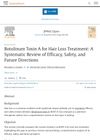TLDR Botulinum toxin type A may widen certain arteries, but more research is needed.
This preliminary report examines the effects of botulinum toxin type A (BoNT-A) on vascular diameter in 5 patients, finding that BoNT-A significantly increased the diameter of the supratrochlear artery from 0.87 ± 0.38 mm to 1.69 ± 0.27 mm, while normal saline had no effect. Although arterial velocity decreased post-injection, this was not statistically significant. The results suggest BoNT-A's potential for treating vascular ischemia due to its vasodilatory effects, but the small sample size limits the findings' generalizability. Further research with larger cohorts is needed to confirm these effects and explore its application in other vascular areas.
 September 2023 in “JPRAS Open”
September 2023 in “JPRAS Open” Botulinum Toxin A may help with hair growth and has some side effects; more research is needed.
52 citations
,
January 2023 in “Toxins” Botulinum toxin can safely and effectively treat facial wrinkles and muscle issues with precise injection techniques.
 53 citations
,
January 2017 in “Skin appendage disorders”
53 citations
,
January 2017 in “Skin appendage disorders” Botulinum toxin shows promise for various skin conditions but requires more research for confirmation and standardized use.
 44 citations
,
October 2017 in “British Journal of Dermatology”
44 citations
,
October 2017 in “British Journal of Dermatology” Botulinum toxin has potential for treating various skin conditions and improving wound healing.
 1 citations
,
May 2008 in “Toxicon”
1 citations
,
May 2008 in “Toxicon” The lowest effective dose of Botox for detrusor sphincter dyssynergia is between 75-100 units.
 5 citations
,
December 2022 in “Toxins”
5 citations
,
December 2022 in “Toxins” Neurotoxins can affect neurotransmitter release and have potential in treating muscle, pain, and cancer conditions, but more research is needed on how they work.
 16 citations
,
March 2022 in “Archives of Toxicology”
16 citations
,
March 2022 in “Archives of Toxicology” Botulinum and tetanus neurotoxins are better understood now, with updated information on their effects and treatment.
23 citations
,
September 2021 in “Clinical Cosmetic and Investigational Dermatology” Botulinum toxin is used in skin care for cosmetic and medical purposes.






